How A Building Explains A City: The Belasco, LA and Punk
Issue 002: The intersection of space, culture and rebellion
Have you ever looked at a building and felt a sudden need to know it’s story? Some places scream that they have a story to tell without ever making a sound. The Belasco in Los Angeles is one of those places.
The first time I saw the Belasco I was struck by the facade. It was lit with a certain air of vibrant fiendishness. The signage and stone were ornate and stunning. It was obviously an older building. And yet the bands I was slated to see were a mix of hardcore punk, grunge rock and doom metal. The music and the venue seemed an odd match.
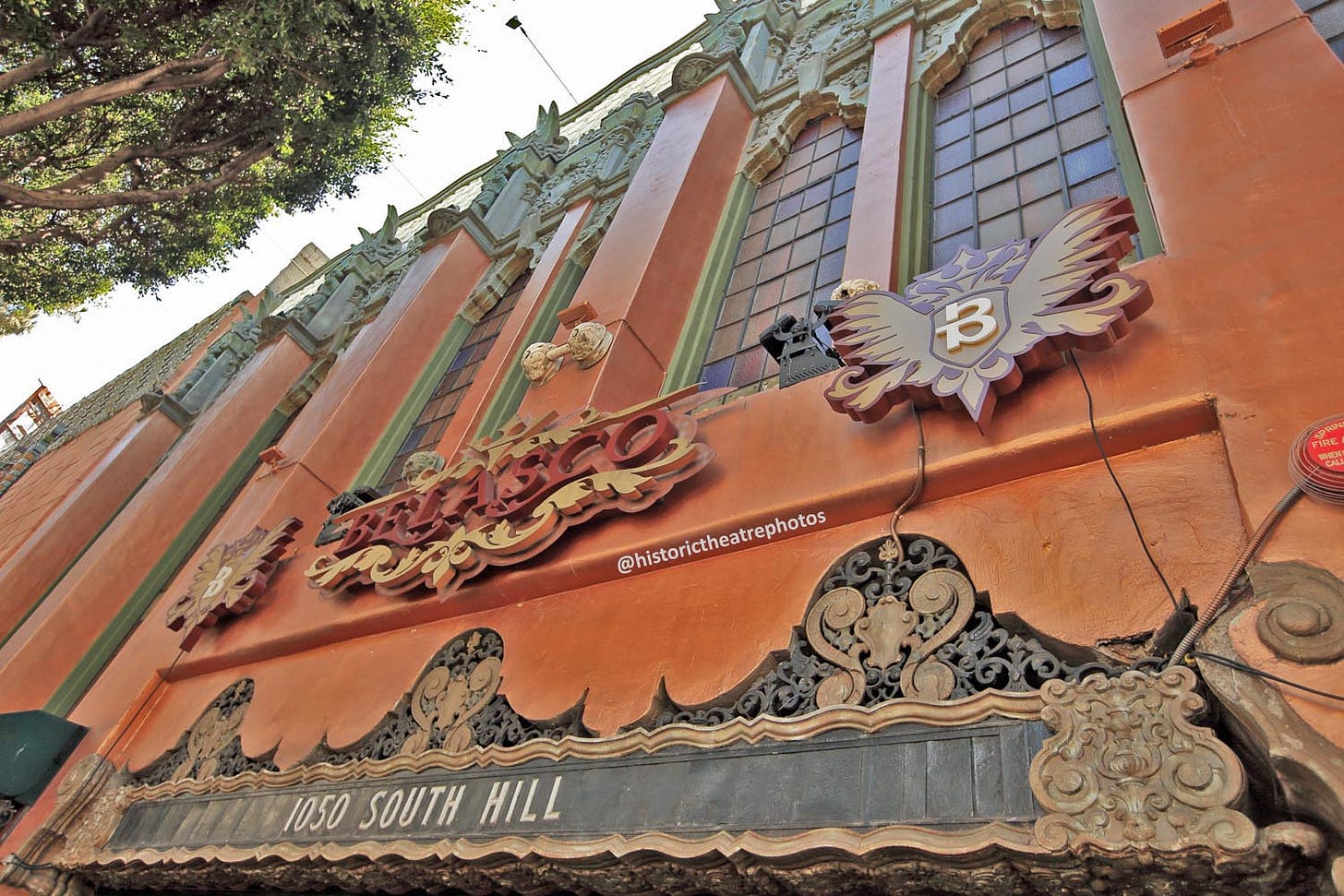
Once I got through security, I went upstairs to get a drink and decided to look up the Belasco on my phone.
“We are the cat with nine lives and counting; the phoenix, diabolically grinning as she molts new feathers. Established as a performing arts theatre in 1926, we have since been called a house of G-d and a dungeon of debauchery. Yet through it all, we are a place with one mission: to elevate creative voices. If spaces have souls — which they do — ours would radiate the scorpionic energies of passion, expression, and transformation.”
How could you read something like that and not want to know more?
The Tar Pit Tycoon
The Belasco was financed by Edward Doheny, an oil tycoon and one of the original robber barons.1 As Historian T.J. Stiles suggests, the term robber baron "conjures up visions of titanic monopolists who crushed competitors, rigged markets, and corrupted government. In their greed and power, legend has it, they held sway over a helpless democracy." This feels about right.
Though one doesn’t associate California with oil in the same way as Texas, there are still numerous active oil wells within the state, and many oil billionaires made their fortunes here.
In 1892, armed with a $400 lease and a eucalyptus tree trunk drilling system of his own design, Doheny became the first person to strike oil in the La Brea Tar Pits. Within three years, the area had over 300 oil wells.

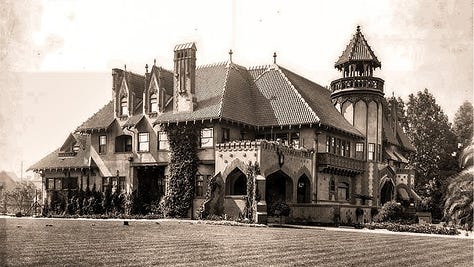
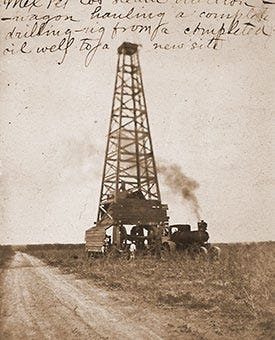
Doheny had a tumultuous personal life even as his business grew. His first child, a daughter, died in 1892. He divorced his first wife in 1899 and gained custody of their son, Ned. She committed suicide the following year and Doheny eventually remarried.
In 1901 Doheny drilled his first oil well in Mexico, and in 1916 one of his wells in Tampico became the world’s largest producing oil well, shooting a stream of oil 598 feet into the air when it was drilled. In the process, he got involved in the Mexican Revolution which put him at odds with the Wilson administration.
Doheny further expanded his operations into Venezuela and Colombia. By 1920, his Pan American Petroleum and Transport Company (PAT) was the largest oil company in the US, ahead of Rockefeller and Standard Oil.
Teapot Dome Boils Over
In 1921, Albert Fall, the US Secretary of the Interior in the Harding Administration and an old friend of Doheny’s, accepted bribes in exchange for leasing oil fields to two oil companies without any competitive bidding. Doheny paid Fall a $100,000 bribe, using his son Ned as a courier. In exchange, Fall leased oil fields in California to PAT. At the same time, Fall leased other fields in Wyoming to Sinclair Oil, also without competitive bidding. The result was dubbed the Teapot Dome scandal.
Doheny was charged with bribing Fall and both were indicted in 1924. Ned and his assistant Hugh Plunkett were also charged. Before Watergate, Teapot Dome was regarded as the biggest scandal in the history of American politics. Years of trials ensued.
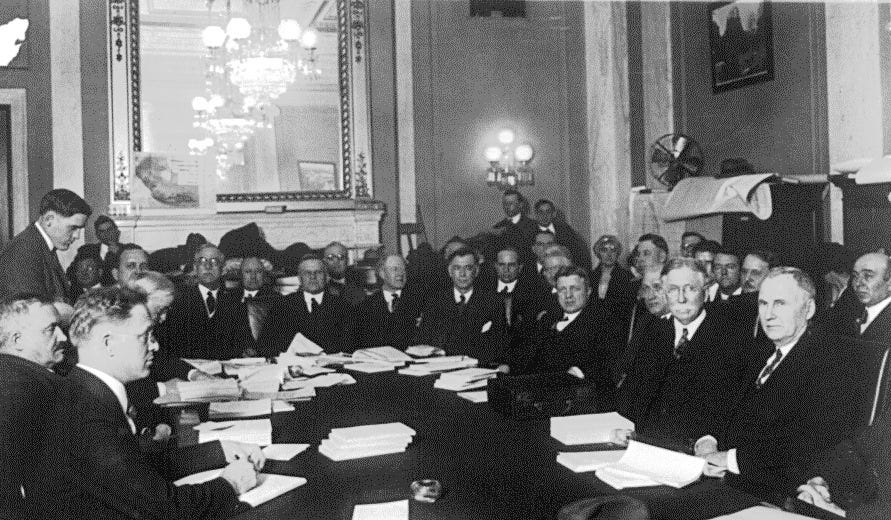
In 1928, in the midst of the scandal, construction finished on Doheny’s Greystone Mansion. With 55 rooms in 46,000 square feet at a cost of $3.1M ($55M in today’s dollars) it was the most expensive home in California. Doheny “sold” the mansion to his son Ned for $10. Ned moved his family into the mansion later that year.
This is where it really gets interesting.
Though Doheny was acquitted of the initial charge in 1924, a second trial was scheduled for the fall of 1929. Doheny and Ned pressured Ned’s assistant (and possible lover) Hugh Plunkett to take the fall for them. They wanted Plunkett to agree to be committed to a mental institution so he could not be forced to testify.
On February 16, 1929, Ned and Hugh Plunkett had an argument at Greystone. Ned shot Plunkett in the back of the head and then shot himself. Though several family members were in the house and heard the shots, the police were not called for three hours. The family doctor was called first and the bodies were moved. In true LAPD fashion, they protected a wealthy family by ruling that Plunkett had murdered Ned and somehow committed suicide by shooting himself in the back of the head.2
Miraculously, Doheny was acquitted of bribing Fall, but Fall was convicted of accepting the bribe. Yes, you read that correctly. I graduated from a good law school and I have no idea how to explain that.
Fall was found guilty on Black Thursday in 1929, the first former cabinet member in US history to be sentenced to prison due to a crime committed while in office. Fall served a year in prison. Adding insult to injury, Doheny’s company foreclosed on Fall’s ranch in New Mexico due to “unpaid loans.”
There Will Be Blood
So why have we heard of Rockefeller and Getty, but not Doheny?
A few reasons. First, after Ned’s death Doheny became a recluse. Second, at his request, Doheny’s widow Estelle burned all of his papers in 1935.
However, Doheny achieved infamy during the course of his life, and our great grandparents almost certainly knew who he was. And many of you know more about him than you realize.
Pulitzer Prize-winning author and political activist Upton Sinclair wrote a 1927 novel called Oil based on Doheny. This novel, and Doheny’s life, were the inspiration for the film There Will Be Blood, where Daniel-Day Lewis played a character modeled after Doheny. The famous “I drink your milkshake” scene was filmed in the bowling alley inside Greystone Mansion (as was much of The Big Lebowski).
The Doheny saga also graced the pages of Raymond Chandler’s novel The High Window. Before becoming an incredibly successful author and screenwriter, Chandler worked his way from bookkeeper to vice president at Dabney Oil from 1922-1932 and was very familiar with the sordid details of Doheny’s rise and fall.
The story behind the man who commissioned the Belasco touches on important historical episodes, from the Mexican Revolution, Teapot Dome and Black Thursday, to the growth of the oil industry, robber barons and murder mysteries. It includes two astounding legal cases. It was depicted in fiction beginning in the 1920s and in film by Academy Award-winning director Paul Thomas Anderson.
The Radical Belasco Is Born
Though the Teapot Dome scandal tainted Doheny’s reputation and gave him a level of infamy, he still had both the time and resources to pay for and oversee the construction of the Belasco (and its sister theater, the Mayan) in 1926.
The Belasco was originally going to be called the Doheny, but the name was changed in honor of director and playwright David Belasco, whose brother Edward was chosen to manage the theater. The name change and management were due to the fact that the theater was built to attract top tier Broadway plays to Los Angeles.
And what a theater it is! Designed with a mix of Spanish Conquistador and Moorish architectural styles, it is absolutely striking from the moment you set eyes on it. The Belasco is one of those buildings that make you ask yourself, “Why don’t we build things like this anymore?”
The Belasco was notable for more than just its stunning architecture. Doheny invested in the latest technology, including a hydraulic orchestra lift and state of the art lighting system. Most importantly, he brought in acoustic experts, including professors from Yale and Stanford, to ensure the acoustics of the theater were perfect.
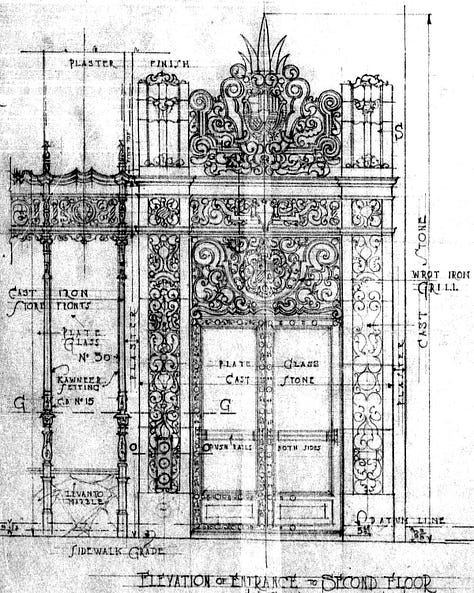
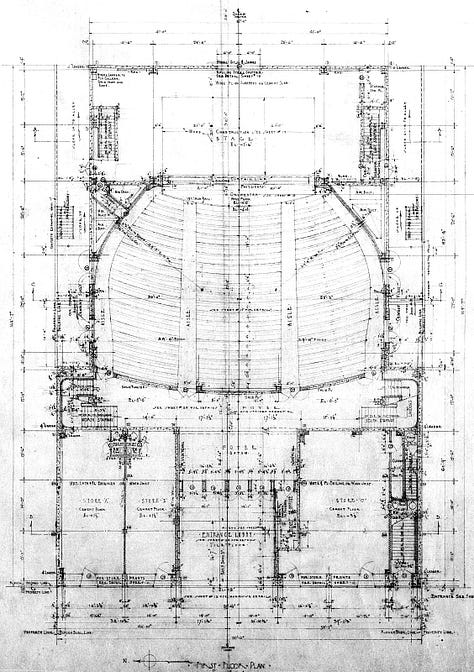
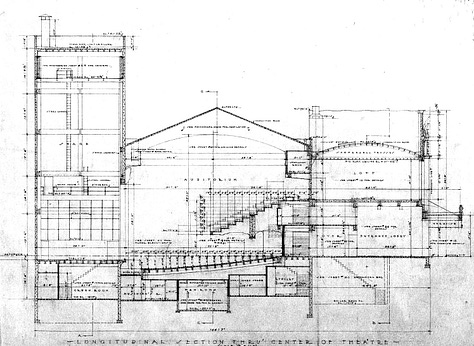
In the 1930s, the Belasco was part of the New Deal by way of the Works Progress Administration’s Federal Theater Project (FTP). The goals of this project were threefold:
To employ out of work creatives
To entertain poor families
To create relevant art
Ninety plus years later, the idea of a federal program designed with any of those goals sounds truly radical. Imagine how it felt back then. The government helping artists? Caring at all about poor families?
Over a four year span, over 30 million people attended FTP productions in over 200 theaters across the country for free. The FTP employed over 15,000 people and helped establish the careers of artists such as Arthur Miller, Orson Welles, Elia Kazan and Susan Glaspell.
The FTP also showcased the work of underrepresented artists, particularly Black artists. The project set up 17 Black theater units and showcased works designed to highlight racial injustice. Focusing on racial injustice during the Jim Crow era demonstrates just how progressive the FTP was.
In its infancy, the Belasco was infused with the radical spirit of the artists who created within it’s halls. There’s something inherently anti-capitalist about a government program offering free entertainment to the public.

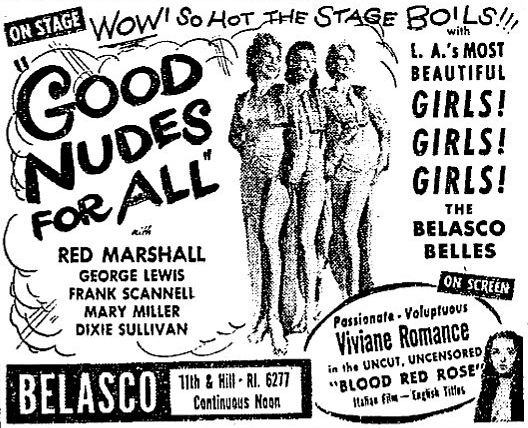
In 1948, the Doheny estate sold the Belasco and it was turned into a burlesque theater that also screened adult films (i.e. porn).
In the coming decades it changed hands again and was eventually purchased by the Metropolitan Community Church (MCC) in 1973. As the venue website explains, the MCC was the first church devoted to LGBTQ+ communities.
In the 1990s the venue began being used for film and music video productions. The list is impressive, from Being John Malkovich to the famous closing performance in the film The Prestige and even a Christina Aguilera music video.
The Genius Loci of the Belasco
The Belasco was renovated and turned into a concert venue in 2011. As the venue website says “If spaces have souls — which they do — ours would radiate the scorpionic energies of passion, expression, and transformation.”
In the falsely idyllic American capitalist way, Edward Doheny was able to force the earth beneath him to serve his purposes. He bent the entire US government to his will and was never held legally accountable. His greed ruined his reputation and ultimately led to the suicide of his only son.
But a building like the Belasco is a work of art. A financier can’t truly own a work of art. True artists know that once they create their art and it enters the world, it ceases to be theirs. It is transformed into something else.
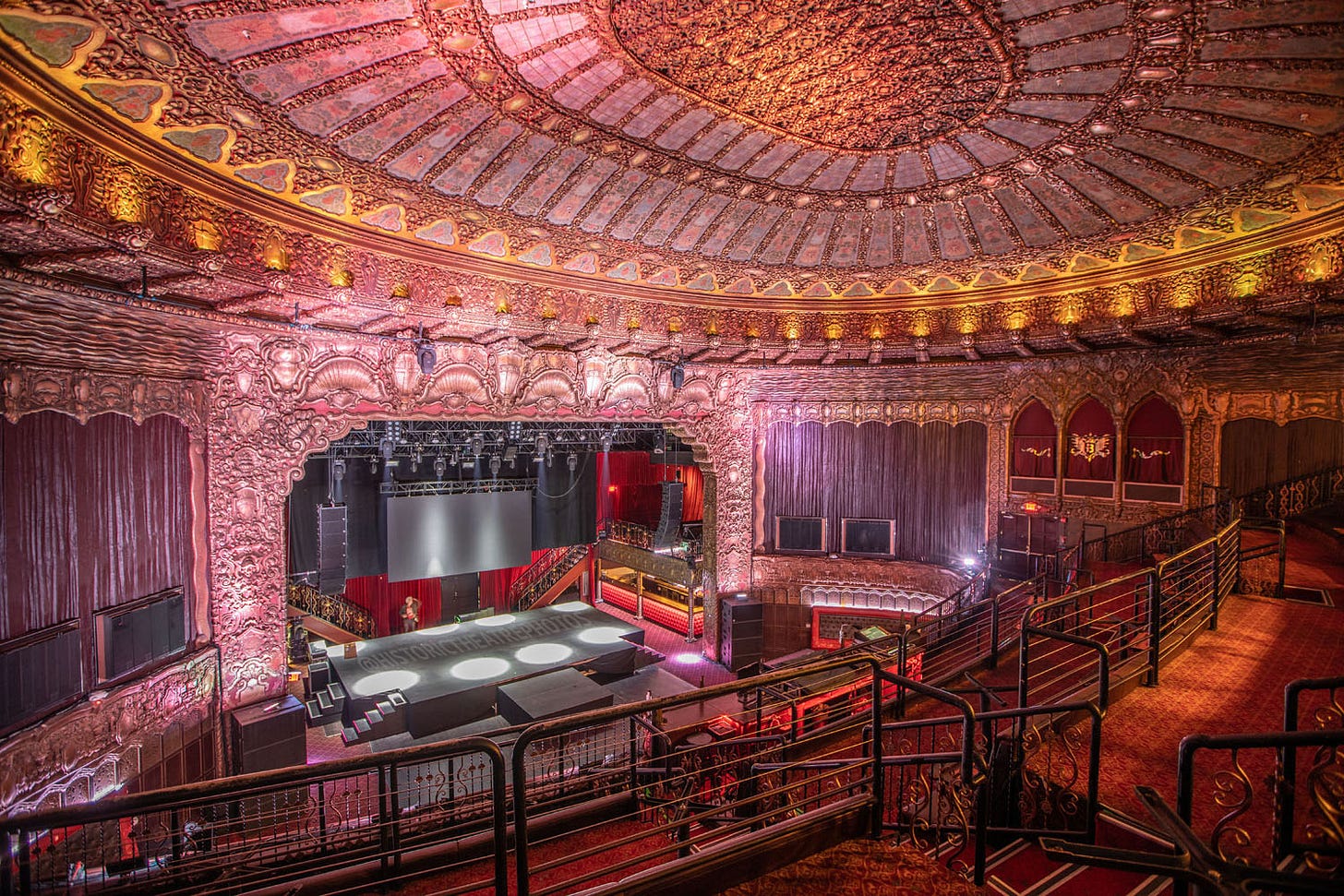
Doheny intended the Belasco to be a venue for legitimate theater, for the most prestigious works from Broadway. A place where well-to-do Angelenos could gather for upscale entertainment. Instead it became a space where poor families could see works of art for free. It transitioned to a venue for burlesque shows and porn films, and then became a early haven for the LGBTQ+ community.
Because of its radical history, punk music feels particularly at home at the Belasco. The best performance I have seen at the Belasco was a punk and hardcore showcase headlined by a group called Show Me The Body.3
The one seed from Doheny’s life that resonates with the spirit of the Belasco is a refusal to accept authority. This spirit animates punk music. Punk is anti-oppressive. It’s a punch to your face. If you’ve ever been in a mosh pit, and then stood right on the edge, you know the feeling. One imagines it's like being swept up by a hurricane and then placed back on the ground. But you can still feel all the energy. The energy of a great punk show could power a city.4
The critical difference between Doheny and punk is that punk artists are anti-capitalists. As Show Me The Body said in a magazine interview, “Money doesn’t care about anybody.”
Though it may seem incongruous, the genius loci of the Belasco is anti-authority and anti-capitalist. It doesn’t matter that it was built by a robber baron or that it’s currently owned by Live Nation, a giant monopoly. A work of art is a living, breathing thing. And the Belasco is animated by its own identity.
The Final Act
Oil tycoons take something dead from the ground and turn it into energy, power and money. Artists help us understand the world around us. They create their own energy. Their power stems from within.
There is always conflict between the business of art and the making of art. Business takes, making gives.
The Belasco was built by someone who wanted to shape the world in his image. A man who wanted more and was willing to hurt people to get it. Doheny was a taker, but the Belasco today surely isn’t the venue he conceived. It’s not for Broadway plays, it’s for punk concerts and drag shows.
I find that encouraging. Ninety eight years after a robber baron built this incredible building, it symbolizes something very different from the values of his life and work. It’s a welcoming, warm, devious space that showcases music rooted in radical, subversive ideas.
I don’t think the arc of the moral universe bends towards justice, as the famous Martin Luther King quote goes. But I know that eventually, even the worst among us die and are forgotten.
Kissinger finally died. Dick Cheney will die one day, and so will Donald Trump.5 And some of Trump’s properties will eventually be sold. And maybe, just maybe, one of them will be turned into a space that showcases great art, which by any definition will represent ideas that he and his supporters either hate or don't grasp.
Stuff To Distract You From The Abyss:
There are a lot of articles out there giving advice on how to cope with the awful political news this week…
Turn to art as a source of hope and comfort6
As one example, check out upcoming shows at the Belasco. I will be going to a bunch in 2025, including Jerry Cantrell (of Alice in Chains) and the L.A. Punk Invasion in March
Read this analysis of journalism's fight for survival in a postliterate democracy
Take time to process grief from the election
Volunteer at a great LA organization like 826LA
Take in a delightful night of puppetry at the Bob Baker Marionette Theater
Note to readers: The origin of this phrase dates back to the Middle Ages when wealthy landowners were called “feudal warlords.” We should bring this term back, as it’s much more accurate and evocative than calling greedy, shitty billionaires “the 1%.”
Though the Doheny’s were staunch Catholics and donated heavily to the Catholic Church and other Catholic institutions, Ned was buried at Forest Lawn, a secular cemetery. This gives further indication that the family knew Ned committed suicide, which meant he would not have been permitted burial in a Catholic cemetery.
Other fantastic performances I’ve seen at the Belasco include Melvins, Boris, The Mission, The Chameleons, Theatre of Hate and Sleater-Kinney
Anti-oppressive art is critical to our survival. Oppressors always want to make people feel small and grind down their spirit. Without anti-oppressive forces we would have gone extinct millennia ago.
The following people will also die: Elon Musk, George W. Bush, Rupert Murdoch, Vladimir Putin, Mark Zuckerberg, Mitch McConnell, Erik Prince, Betsy DeVos, Stephen Miller, Sarah Huckabee Sanders, Benjamin Netanyahu, Tucker Carlson and even Peter Thiel, despite his obsession with immortality.
I saw LCD Soundsystem at the Hollywood Palladium last weekend. It was an infusion of joy when I needed it the most, the crowd was in need of catharsis and the music delivered exactly that. I would humbly suggest that anyone feeling despair or anger try and find a way to experience some joy in the dark days ahead.



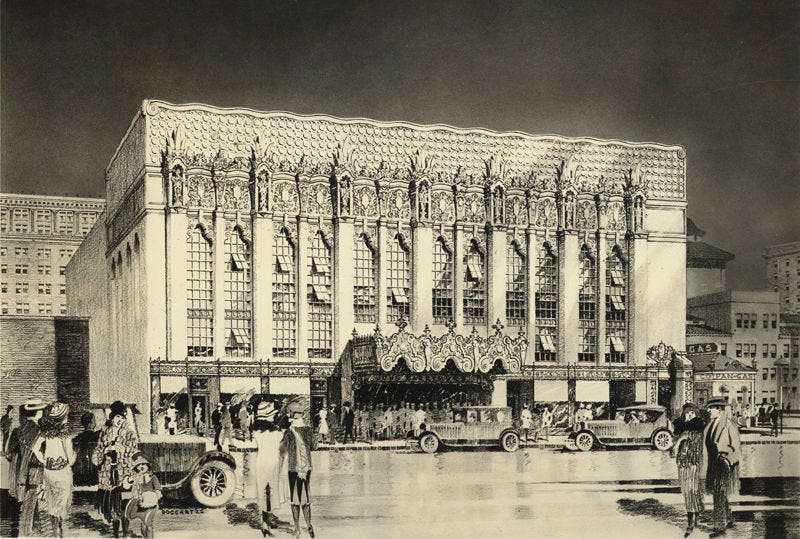
Wow, what a fascinating history! The opulence of this venue is breathtaking.
I definitely need a punk-night-out at the Belasco to soothe the pain inflicted last week*
* Footnote #5 😂👍👍
I very much enjoyed your article. What a fascinating story. I hope I can see a show there someday .